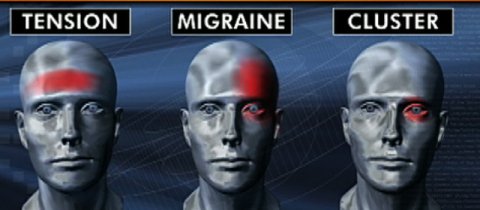Headache
Headache
Tension headache, Migraine, Cluster Headache
Headache is pain in any part of the head.

Primary Headaches:
A primary headache is caused by dysfunction or overactivity of pain-sensitive features in your head.
Chemical activity in your brain, the nerves or blood vessels of your head outside your skull, or muscles of your head and neck — or some combination of these factors — may play a role in primary headaches.
The most common primary headaches are:
- Cluster headache
- Migraine (with and without aura)
- Tension headache (medically known as tension-type headache
Migraine is different from tension-type and cluster headaches, and usually causes symptoms of sickness or nausea in addition to a severe, one-sided, throbbing headache. However, some people experience both migraines and tension-type headaches.
MIGRAINE:
Migraines are chronic headaches that last for hours or even days which can completely disable a person. Some migraines are preceded or accompanied by symptoms or signs (auras), such as giddiness, often nausea, vomiting, and extreme sensitivity to light and sound, flashes of light, blind spots or tingling in the arm or leg. Not all migraines are the same. Most people experience migraines without auras.
Some people may have one or more sensations of premonition (prodrome) about the headache several hours or a day or so before the headache actually strikes. Prodromal symptoms include:
- Feelings of elation or intense energy
- Cravings for sweets
- Thirst
- Drowsiness
- Irritability or depression
Migraines usually begin in childhood, adolescence or early adulthood. A typical migraine attack produces some or all of these signs and symptoms:
- Moderate to severe pain, which may be confined to one side of the head or may affect both sides
- Head pain with a pulsating or throbbing quality
- Pain that worsens with physical activity
- Pain that interferes with your regular activities
- Nausea with or without vomiting
- Sensitivity to light and sound
When untreated, a migraine typically lasts from four to 72 hours, but the frequency with which headaches occur varies from person to person. Migraines can occur several times a month or much less frequently.
Cluster Headache:
Cluster headaches, on the other hand, begin quickly and are one-sided, short-lived, excruciatingly painful headaches.
They can recur frequently for several weeks and then subside, but another bout may develop some months, or up to a year, later. Sleep is often disrupted, with the headache causing you to wake up at the same time each night. The eye on the side of the headache often becomes inflamed and watery and you might have a blocked nose on the affected side.
Secondary Headaches
A secondary headache is a symptom of a disease.
Causes of secondary headaches include:
- Sinus inflammation and congestion
- Trauma to the head
- Inflammation of the lining of the blood vessels
- Brain tumor
- Disease of the eye
- Inflammation of the membranes and fluid surrounding your brainArterial tears
- Blood clot within the brain
- Brain aneurysm (a bulge in an artery in your brain)
- An abnormal formation of blood vessels in the brain
- Structural problem at the base of your skull
- Brain inflammation
- Blood vessel ruptures in the brain
- Increased pressure inside the skull
- Stroke
- Irritation of f the sensory nerve supplying the face and brain
Tension Headache:
A tension-type headache is the most common type of primary headache. The headache is usually described as mild to moderately intense. The severity of the pain varies from one person to another, and from one headache to another in the same person.
Many people have 1 or 2 headaches of this type every month. Sometimes they develop more frequently, typically during times of stress. Approximately 3% of people have a tension-type headache on most days. When this happens, the headaches are called chronic tension-type headaches.
Tension-type headaches usually last only a few hours, but some people may have more persistent headaches that last for several days. They are more frequent in women compared to men. Typically the symptoms include a constant ache, which affects both sides of the head with tightening of the neck muscles and a feeling of pressure behind the eyes.
Signs and symptoms:
- Dull, aching head pain
- The sensation of tightness or pressure across your forehead or on the sides and back of your head
- Tenderness on your scalp, neck and shoulder muscles
- Occasionally, loss of appetite
A tension headache can last from 30 minutes to an entire week. A person may experience these headaches only occasionally, or nearly all the time. If the headaches occur 15 or more days a month for at least three months, they’re considered chronic. If the headaches occur fewer than 15 times in a month, they are considered episodic. However, people with frequent episodic headaches are at a higher risk of developing chronic headaches.
Tension headaches can sometimes be difficult to distinguish from migraines.
